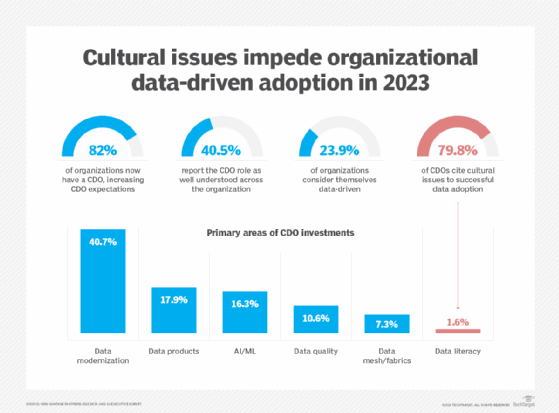Use these 10 steps to successfully build your data culture (original) (raw)
Building a data culture starts at the top level of any organization. These 10 steps can help guide leadership through the key aspects any data culture needs to succeed.
Leadership is responsible for building a data culture to empower all the employees in their organization with data, which doesn't happen overnight. It starts by following the right steps to develop and execute a plan that fits their goals.
A data-centric culture encourages employees to use and experiment with data to improve efficiency and decision-making. Data cannot be just another tool for decision-makers to consider; it should be an integral part of the processes and identity of the organization. Senior leadership sets the example for the rest of the organization. If they do not trust data to use it as the main driver behind decisions, then other employees won't either.
The chief data officer leads the organization's strategy of creating value from its data assets, but CDOs face many challenges. According to NewVantage Partners' 2023 "Data and Analytics Leadership Executive Survey," 82.6% of organizations employ a CDO, but only 40.5% of those organizations clearly understand the role of their CDO. Additionally, only 23.9% of organizations consider themselves data-driven, a decline from the 26.5% reported in the 2022 survey.
In the 2023 survey, 79.8% of CDOs cited cultural issues as their primary challenge in creating a data-driven organization. However, only 1.6% of the CDOs prioritize AI and data literacy compared to their other data and analytics investments. Those numbers don't add up (Figure 1).

Figure 1. Chief data officers find cultural issues to be the biggest roadblock for data adoption but aren't investing in data literacy.
Championing and empowering a data-driven, value-centric culture should be the CDO's top priority to improve the accuracy and efficiency of data-driven decision-making. Accomplishing these goals requires the CDO to lead the initiative to empower everyone in the organization to identify where and how to use AI and data to drive new sources of customer, product, service and operational value.
10 steps to build a data culture
There are 10 steps CDOs can take to build a data culture in their organizations. Each step presents challenges and might require different strategies or approaches. The 10 steps affect the business to varying degrees. Some are more difficult to execute than others, but they each play a role in building a successful data culture.
1. Align analytics and business strategies
The first step to building a successful data culture is to link the data and analytics strategy to the organization's business and operational strategies. Organizations struggle with understanding the economic value of data and how to extract that value. Leadership should communicate about how the vision, mission and goals of the data and analytics strategy support the business strategy. Demonstrate how data and analytics can create new sources of customer, product, service and operational value.
2. Foster a culture of collaboration and experimentation
Create a data and analytics culture that fosters collaboration, experimentation and the sharing of learning around value creation. Many organizations lack a formal data and analytics literacy foundation to drive awareness and empowerment among employees. Educate stakeholders on how data and analytics can create value. Engage business stakeholders by integrating their requirements, desired outcomes and KPIs into analytics models. Reward data and analytics advocates, and understand the role of failure as a learning and growth mechanism.
3. Use data and analytics for innovation
Data and analytics are a valuable resource to create new products, services and business models. The lack of stakeholder empowerment and organizational agility, which enable organizations to explore and identify new business opportunities, can hinder the benefits of innovation. Leadership should adopt a collaborative, value-centric methodology that uses design thinking, rapid prototyping, minimum viable product development and experimentation to explore new business opportunities. Use data and analytics to access, blend and analyze internal and external data sources with AI to create new customer, product and market revenue streams.
4. Develop a use case roadmap
Develop a use case roadmap that outlines the short-term and long-term goals, milestones and deliverables. The roadmap is only successful if stakeholders and data teams work together to identify the desired outcomes. Create a cross-functional steering committee, working groups and feedback mechanisms. Align the roadmap with the organization's strategic priorities and data and analytics capabilities. Monitor and adjust the use case roadmap as needed.
5. Cultivate talent
A common challenge that organizations encounter when becoming more data-centric is a lack of data skills among employees. Nurture and align data and analytics talent and skills with organizational needs. Recruit, train and retain data and analytics professionals. Create a data and analytics career path and learning culture that motivates and rewards employees. Establish communities of interest to accelerate skills development.
It is everyone's responsibility to ensure AI and data use deliver more relevant, meaningful, responsible and ethical business and operational outcomes.
6. Form an advisory council
Establish a business advisory council chartered with the prioritization and funding of AI and data-based business initiatives. The council can coordinate AI and data asset management across the organization and empower business units. It can also decide how to prioritize data and analytics initiatives based on the value impact and feasibility. Show ROI and value creation from data and analytics projects. The advisory council won't succeed as an IT initiative; senior business management must co-lead the council for it to succeed.
7. Establish a data management framework
A data management framework ensures data quality, security, privacy and ethics compliance. Ensure business stakeholders understand the role data management and data governance play in delivering relevant and meaningful outcomes. Implement data and analytics governance policies to ensure data quality, security, privacy and ethics. Monitor and audit data and analytics activities and outcomes.
8. Use proven technologies
Too many technological advancements can distract CDOs from their focus on value creation. They must build a data and analytics foundation that uses the most appropriate and proven technologies. Ensure alignment and integration of data and analytics technologies with business processes. Adopt a data architecture that enables data agility, sharing and scalability. Use AI to generate business insights and recommendations from the data.
9. Improve performance with external providers
Partnering with external data and analytics providers can enhance the organization's data and analytics capabilities. Leadership should assess the current internal data and analytics capabilities to identify gaps or areas that need improvement. Identify external data and analytics providers that offer complementary data and analytics capabilities. Manage partnerships to ensure quality, security, privacy and ethical application of the data and analytics assets.
10. Identify, monitor and report KPIs
To ensure cultural measures align with business measures and achieve the desired outcomes, leadership should define KPIs or other metrics to measure cultural transformation effectiveness. Conduct collaborative workshops to identify, validate, value and prioritize cultural metrics. Map metrics to business strategies to ensure organizational buy-in and alignment. Report progress and issues transparently and frequently.
Behind the success of each step is the empowerment of everyone in the organization -- especially frontline employees who cultivate ideation and innovation -- to become citizens of data science. Empowering citizens of data science involves integrating the disciplines of data science, design thinking and data economics to ensure everyone understands their role, responsibilities and rights. It is everyone's responsibility to ensure AI and data deliver more relevant, meaningful, responsible and ethical business and operational outcomes.
Integrating these disciplines can help organizations empower their employees in a data-driven, value-centric culture. A healthy data culture enables data and analytics to enhance the customer experience, improve operational efficiency and achieve business differentiation.
Bill Schmarzo is former CIO of Hitachi Vintara, where he was recognized for groundbreaking work in data science and automated machine learning. He has also worked at Dell EMC as CTO and as VP of analytics at Yahoo. He has also written several books on big data.
 Modernizing talent one of the keys to analytics success
Modernizing talent one of the keys to analytics success  By: Eric Avidon
By: Eric Avidon  Key roles and responsibilities of the modern chief data officer
Key roles and responsibilities of the modern chief data officer  By: Peter Spotts
By: Peter Spotts  The evolution of the chief data officer role
The evolution of the chief data officer role  By: Bill Schmarzo
By: Bill Schmarzo  6 CDO challenges that hinder data-driven initiatives
6 CDO challenges that hinder data-driven initiatives  By: Mary Pratt
By: Mary Pratt